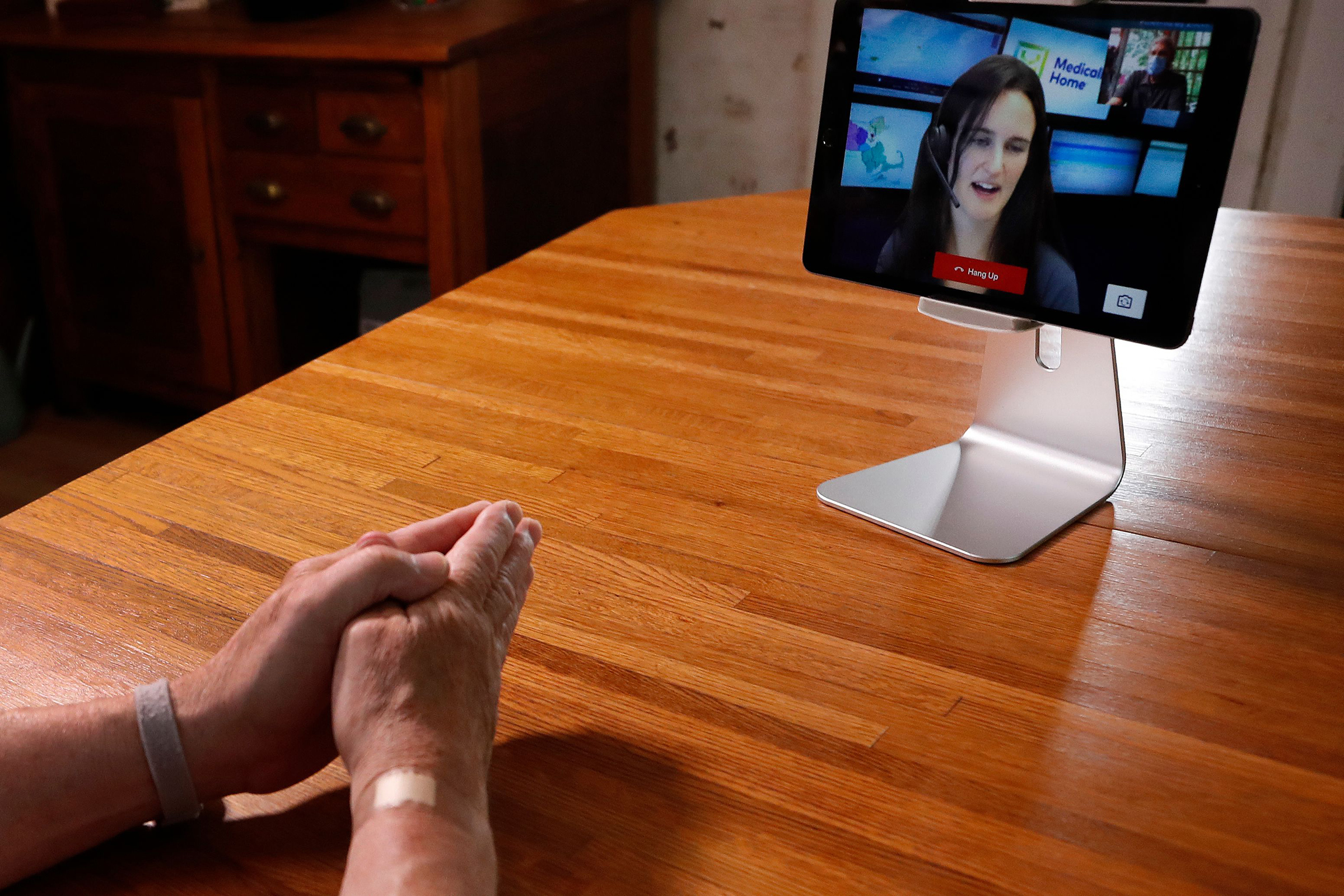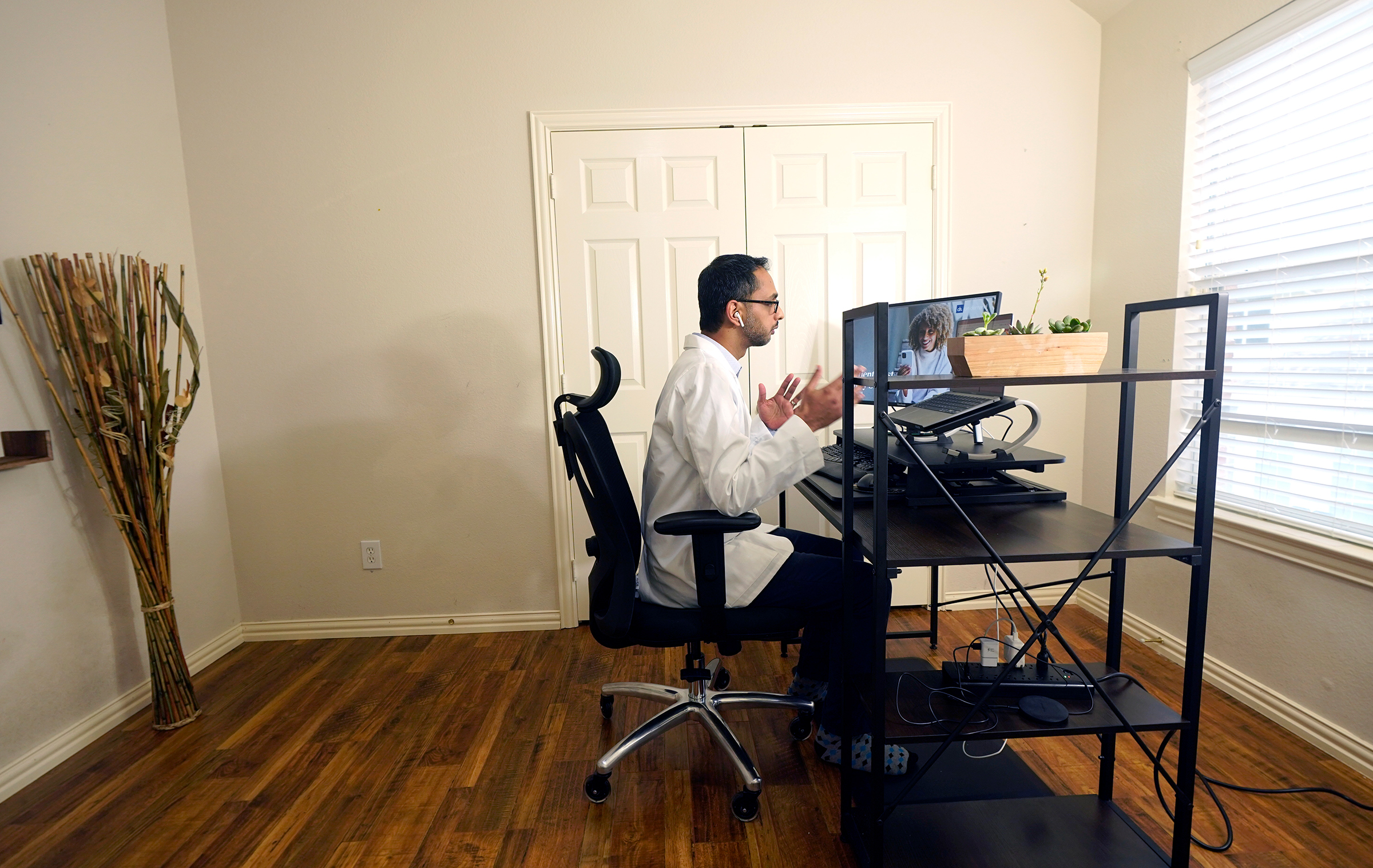
Telehealth use exploded during the early days of the COVID-19 pandemic, and virtual visits have become common for a wide range of medical services. But this was only possible because of regulations the government relaxed during the public health emergency. Now, as the virus begins to release its grip on the United States, telehealth companies and medical groups are pushing to make these pandemic-inspired changes permanent.
Congress recently extended many telehealth changes for five months after the Biden Administration declares an end to the public health emergency, which is currently scheduled to expire on April 16. While it is widely expected that President Joe Biden will extend the public health emergency again, he has been under increasing pressure to unwind pandemic precautions. The congressional extension temporarily eases concerns about a “telehealth cliff” that could abruptly end coverage for virtual treatment, but telehealth lobbyists want to go further.
Proponents of telehealth argue that the regulatory changes have done away with outdated, cumbersome limitations and that expanding telehealth improves access and convenience for patients. But some policymakers still have questions about the quality of care telehealth can deliver, the cost of expanding it further, and the potential for fraud in virtual care.
“Given how much we still do not know about telehealth with respect to cost, outcomes, quality— whether it is adding costs to the Medicare program or saving Medicare dollars—we believe it would be premature to make these expansions permanent,” says James Matthews, executive director of the Medicare Payment Advisory Commission (MedPAC), which advises Congress on Medicare. MedPAC will collect data in 2021 and 2022 so that it can study what “more of a steady state” of telehealth use looks like compared to 2020 when many people avoided leaving their homes, says Mathews.
Telehealth existed before the pandemic, but federal regulations “didn’t really allow for widespread use of the tool,” says Jacqueline Marks, a senior manager at Manatt Health. Among other restrictions, Medicare would only cover telehealth visits for seniors who lived in rural areas and who accessed their virtual visits at qualifying sites, not in their own homes. It also limited the types of providers who could offer telehealth and did not pay providers the same for virtual visits as for in-person ones. Because private insurers and Medicaid programs often follow Medicare’s lead, medical providers could only get reimbursed for telehealth visits in limited circumstances.
Once Congress loosened these rules in 2020, telehealth use skyrocketed. Medicare patients used telehealth 88 times more during the first year of the pandemic than they had previously, according to a report from the Department of Health and Human Services Office of Inspector General. Telehealth claims for non-seniors also increased, and telehealth companies saw an influx of cash. Last year, equity funding to telehealth reached nearly $18 billion, according to CB Insights, a 57% increase from 2020. “There is no doubt that telehealth saves lives,” Department of Health and Human Services Secretary Xavier Becerra said at a press conference this month. “We would be really closing our eyes to a new form of quality health care if we did not expand authorities for telehealth to be available to Americans.”
Telehealth has rare bipartisan support and some powerful champions in Congress. But with concerns about quality, cost, and potential fraud lingering, the industry is ramping up its lobbying efforts to make sure that its gains don’t slip away. And in the meantime, millions of Americans are wondering what their health care will look like in the future.
“This has changed our entire healthcare ecosystem forever,” Marks says. “I think everyone’s just trying to figure out right now, how do we go forward?”

An increase in lobbying
Telehealth has a wide array of advocates on both sides of the aisle pushing for its expansion, even in a time when Congress is often struggling to pass bills amid a fierce partisan divide.
Lawmakers like Democratic Senator Brian Schatz of Hawaii and Republican Senator Tim Scott of South Carolina have each championed bipartisan telehealth legislation, and everyone from digital health companies to hospitals, physicians, insurers, and non-health related employers want to see telehealth stick around.
Traditionally, telehealth hasn’t had a unified lobbying powerhouse. While groups such as the American Hospital Association (AHA), the American Medical Association (AMA) and Pharmaceutical Research and Manufacturers of America (PhRMA) are used to spending millions of dollars each year to lobby for their preferred issues, the American Telemedicine Association spent a more modest $120,000 on lobbying last year.
But those other interest groups have increased their lobbying on telehealth during the pandemic, uniting to leverage diverse factions behind similar goals. They want the loosened telehealth rules made permanent, and they also want Medicare to continue to pay for telehealth visits at the same level as it pays for in-person visits, to extend coverage for both video and audio-only telehealth visits, and to allow providers to practice across state lines beyond the pandemic.
In December 2021, major players such as the AMA and AHA teamed up with Teladoc, AARP, and corporate giants like Amazon, Walmart, and CVS to form a new coalition called Telehealth Access for America, aimed at pushing for more permanent expansions of telehealth. In January, the American Telemedicine Association, which is also part of the coalition, launched its own advocacy arm called ATA Action to increase its advocacy efforts. Kyle Zebley, executive director of ATA Action, said the group’s lobbying footprint will grow this year as it coordinates priorities among those with wide ranging interests. “You can expect us to be significantly more invested in the direct technical lobbying efforts,” he says.
Challenges ahead
But for all the support behind expanding telehealth, some lawmakers and industry experts are wary of making sweeping changes to how Americans see their doctors without more data.
One of the most important areas experts want to evaluate is the quality of care that telehealth delivers. “What has been the impact on quality? Have there been any concerns? Has it improved quality? We don’t really know,” says Dr. Ateev Mehrotra, associate professor of health care policy and medicine at Harvard Medical School.
The omnibus package in which Congress gave telehealth changes a five month extension also directed MedPAC to study telehealth expansion, and the commission plans to look at questions around quality as part of its work. To see how telehealth affects patient outcomes, Mathews says MedPAC will aim to compare hospitalizations and emergency department visits from 2019 when there was less telehealth use to those visits in 2022 and 2023.
Collecting this data would likely require telehealth to stay around for a year or two beyond whenever the public health emergency ends. MedPAC’s report is due in June of 2023, but MedPAC favors a temporary extension for at least that time rather than permanent rule changes. If Congress continues temporary extensions until then, that could be “frustrating” for telehealth companies and providers, says Thomas Ferrante, a health care lawyer at Foley & Lardner and a member of the firm’s telemedicine team. “That’s very hard for long term planning, it’s very hard for an allocation of capital resources. And it’s hard to really message to your patients,” he says.
Telehealth advocates argue the push for more data needs to be balanced with an imperative for speed. “What we don’t want to do is study this thing to death and leave people out, forget the human component, tell the people who are using it, who are benefiting from it, that they have to sit on the sidelines while we crunch some more numbers,” says Claudia Tucker, senior vice president of government affairs at Teladoc.
Concerns about cost also present a barrier. MedPAC is researching whether telehealth is taking the place of in-person visits, or if it’s supplementing them, which could add costs to the government program, Matthews says. And MedPAC will also be studying potential fraud in telehealth use for Medicare patients.
Other congressional advisers have raised concerns too. The Congressional Budget Office found in December 2020 that ending geographic restrictions for coverage of mental health through telehealth would add costs to Medicare, and the Government Accountability Office told the Senate Finance Committee last spring that expanding telehealth could lead to higher costs and potential fraud.
But even if the public health emergency and its flexibilities end this year, the telehealth advocates see Congress’ five month extension as a chance to keep making their case in every way they can. Health care company Amwell has conducted polling about consumer interest in telehealth that it aims to use in its advocacy, and Teladoc says it has received interest from patient advocacy groups that want to help push for expanding telehealth policies.
“People have tasted what it feels like when health care can work on their own terms in their environment,” says Dr. Roy Schoenberg, president and CEO of Amwell. “Because these technologies so profoundly changed the experience of the American patient, I think this is a very, very different kind of dynamic. I don’t think you can stop it at this point.”
More Must-Reads From TIME
- The 100 Most Influential People of 2024
- Coco Gauff Is Playing for Herself Now
- Scenes From Pro-Palestinian Encampments Across U.S. Universities
- 6 Compliments That Land Every Time
- If You're Dating Right Now , You're Brave: Column
- The AI That Could Heal a Divided Internet
- Fallout Is a Brilliant Model for the Future of Video Game Adaptations
- Want Weekly Recs on What to Watch, Read, and More? Sign Up for Worth Your Time
Write to Abigail Abrams at abigail.abrams@time.com